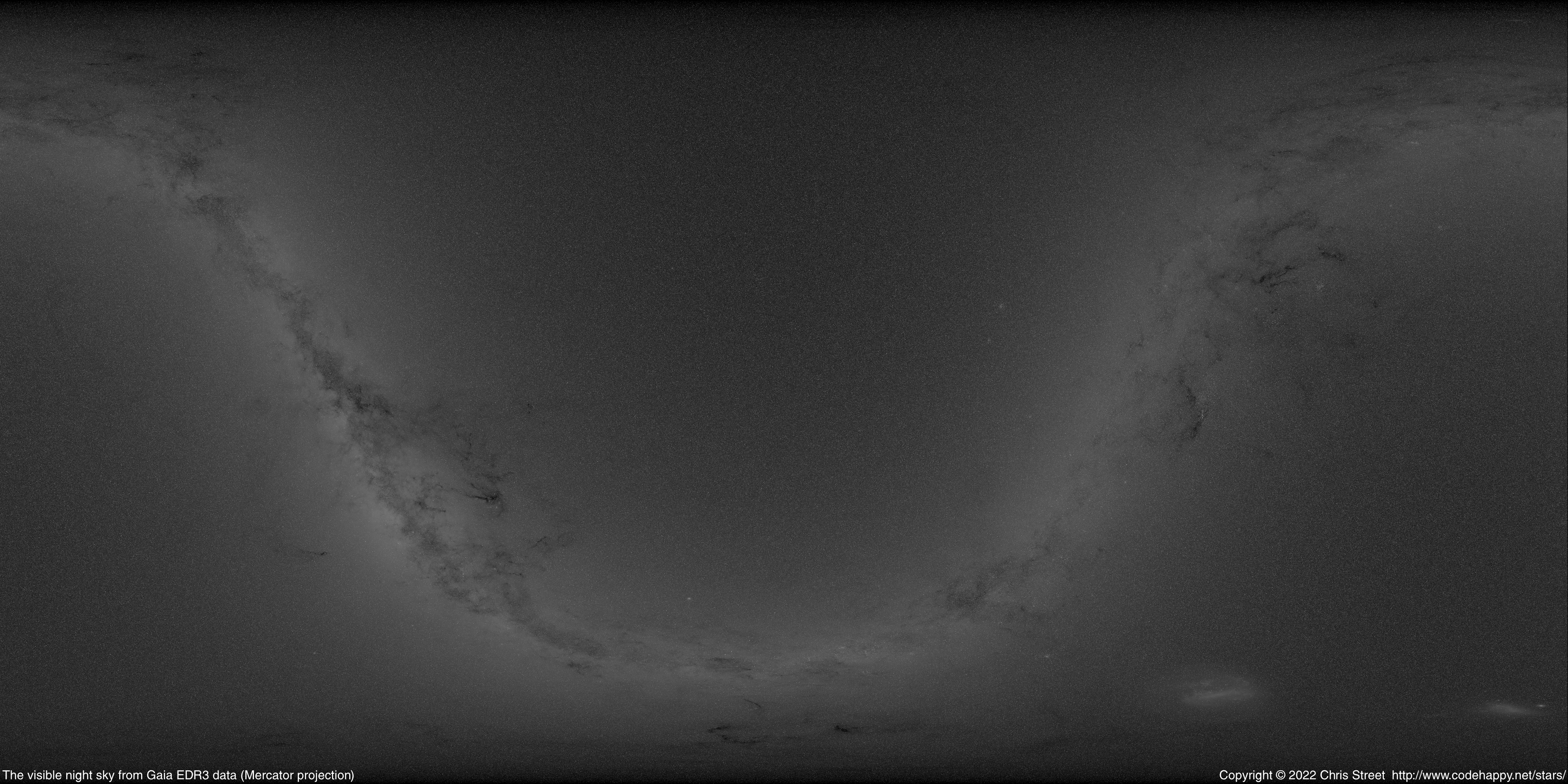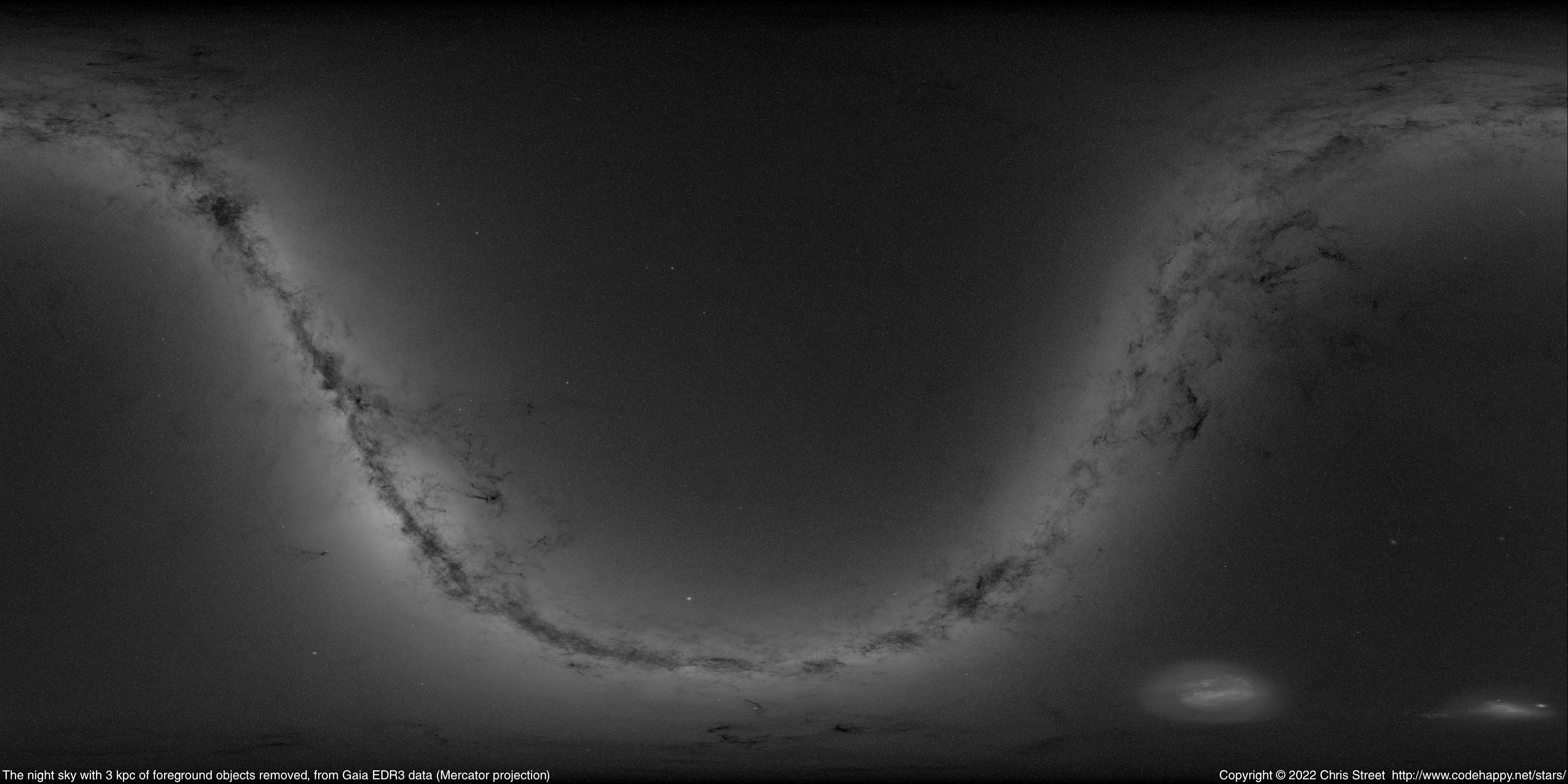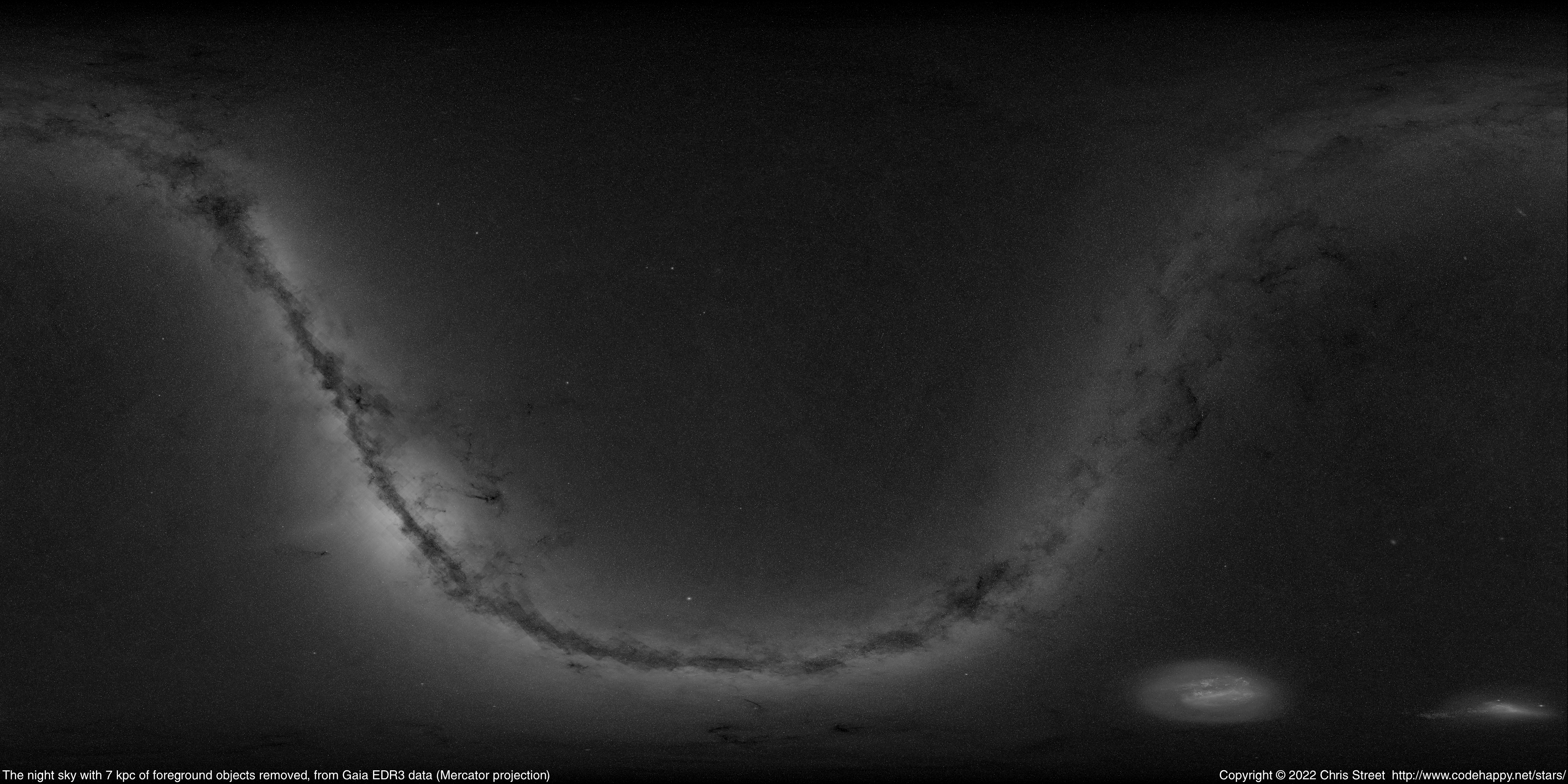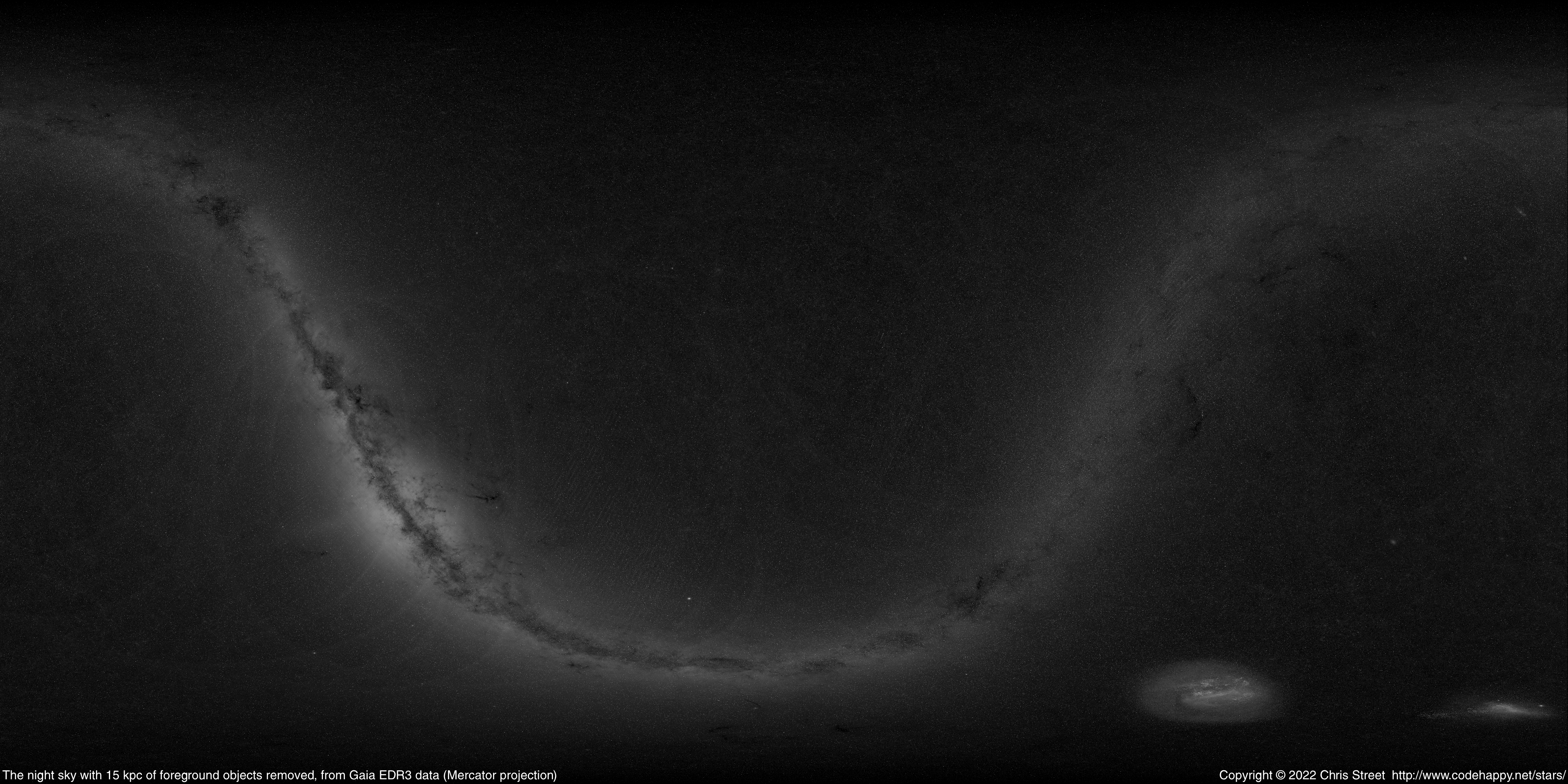Galactic Cartography For Beginners (part 2)
Poking about in the structure of our galaxy with Gaia EDR3 data.
Chris Street, 29 Jan 2022
[Experiment 3] Let's look at the far Milky Way. That sounds like a normal weekend activity.
As we saw in the first experiment, to see the nearby spiral structure of the galaxy, it was sufficient to use
the Gaia EDR3 parallaxes directly to calculate distance. For this experiment, however, we'd like to penetrate a little
deeper, and that requires a slightly different method.
We want to probe the far portion of the Milky Way in this experiment. We want to see the far spiral arms, distant satellite
galaxies, deep halo stars, and whatever other things we can find. If only we had comic book style X-ray vision, and could just see
through things like Superman. (Real
X-ray vision is of course a thing in astronomy, but here we're working just with visible light so we're going to want the comic book kind
that seems to work on everything.) Well,
we sort of can have it. We can do it with science, because (in the words of the immortal Mr. Nye) science rules.
Bailer-Jones et al. (2021) have done a few things that will
be helpful to us here: first, they apply a correction for a zero-point bias in the Gaia EDR3 parallax, and then, using photometric and geometric models, produce
distance estimates that are (on average) more accurate than the estimates you get by simply inverting the measured Gaia parallax.
These models take additional data, such as the star's color and extinction maps ("dust maps") of the Milky Way, into account.
|
(If you're wondering how star color factors into a distance calculation, it's because a star's color gives information about
its absolute magnitude. For example, a red giant makes most of its energy by fusing its little remaining hydrogen via
the CNO sequence. This information limits the luminosity/absolute magnitude of the star to a rather small interval:
thanks to all the hard-working particle physicists, we know exactly how much energy these fusion reactions create and thus how
bright such a star must be. If you know the absolute magnitude and apparent magnitude of a star, it's easy to determine its
distance; this measurement can be even more accurate than a parallax determination for distant stars, if you can estimate
the vabs sufficiently well.)
|
Without the Bailer-Jones et al. corrections, only about 15% of all Gaia sources have a parallax measurement with a signal-to-noise
(PX/PXerr) greater than 5. With the Bailer-Jones et al. corrections, just under half of Gaia sources have distance measurements
satisfying that inequality, at least according to their expected standard errors. (The underlying model is partly probabalistic
and designed to decrease average distance error across large samples of Gaia stars, so whether it actually refines a specific individual source
measurement is anybody's guess. Fortunately we're not using specific sources; we're using the entire Gaia dataset of nearly 2 billion sources in this experiment, so we'll count on
non-systemic errors averaging out.) The Gaia sources that still have poor signal-to-noise are overwhelmingly distant objects.
In other words, after applying the corrections, we still don't have very accurate distances for objects on the other side of
the galaxy (over 20,000 parsecs away), but we do have sufficiently accurate measurements for closer objects. For the experiment we're
about to do, errors as much as 20%-30% either way aren't going to matter a lot, and the great majority of nearby sources will be
well within that range.
When you look at the Milky Way, you're not just seeing the galaxy's nearby spiral arms, you're also seeing the far spiral arms shining
behind them. How can you distinguish one from the other?
If you want to see the stuff in the back -- but you don't know exactly where the back is -- the simplest answer is to subtract the stuff in
the front. We know reasonably well which stars are in the galactic foreground, for foregrounds up to 10 Kpc or a little more -- our
distance estimates are in aggregate accurate enough to get pretty clean results up to that distance. We can use
that information to reveal the Milky Way behind the nearby objects.
So let's check out our new X-ray specs and take a peek behind the foreground stars. (Sorry, but this X-ray vision doesn't
work on the galactic dust clouds. Even Superman has his limits, or so I'm told.)
We begin with the visible sky; here it is, our plaything:

|
Rectangular (Mercator) projection of the full Gaia EDR3 dataset. 0h right ascension is at the left and right edges, and increases right to left; 12h in
the middle. -90° declination at bottom (south), 90° declination at top (north). Click the plot for full resolution.
|
With almost 2 billion stars to plot, it looks a lot like a long exposure photographic plate. (This is a 4,000 × 2,000
pixel image, as are all the other full-sky plots on this page; you are encouraged to click and examine them in full size.)
The foreground dust lanes that follow along the galactic plane, like the Great Rift, are easy to spot in any picture of the
galaxy, but the foreground dust lanes away from the galactic plane are much clearer in a plot like this. Those dust lanes are mostly
relatively close to us (2K-3K parsecs).
This is the only picture in this series that has the familiar stars and constellations visible (we're about to look straight through them with our unearthly powers), although all but the brightest are difficult to pick out.
Orion's sword and the various dark nebulae associated with Orion Molecular Cloud Complex are quite prominent: look for a dark cloud shape in the Milky Way about 1/4 from right, nearly centered vertically.
A bright line of vertical stars in front of the lower portion of the dark cloud is the sword; once that is identified the rest
of Orion is easy to see. (Note that far northern or southern constellations, like Ursa Major, will be spread out on this map; it's a Mercator projection after all.)
All very good, but nothing we haven't already seen. Let's put these X-ray specs on.
Here is the visible sky, after subtracting 3,000 parsecs of foreground stars:
In this view, almost all of the Orion spur is gone, including nearly every naked eye-visible star, but the Perseus and Scutum-Centaurus spiral arms have barely even been touched. The galaxy is big.
- The shape and structure of the Magellanic Clouds at lower right is much clearer; the peripheries of the LMC and SMC are especially easily seen now. (The Large Magellanic Cloud's central bar, the 30 Doradus region, and the remains of its spiral arms are prominent in all of the plots.)
- A great many stars above and below the galactic plane have disappeared. Although there are many stars in the Milky Way's halo, most of the luminosity in this
region (as viewed from Earth) comes from disk stars, much closer to us than 3,000 pc. These nearby stars only appear from Earth to be far above or below the disk; in actuality they're right
in the galactic disk with us, just nearby and above or below us a few hundred light years at most.
- Since the nearest stars are now almost 10,000 light years away in this view, the Milky Way galactic plane far outshines all the
stars out-of-plane: not only in total luminosity but also in the density of its brightness. Accordingly, the galactic plane itself
appears (relatively) brighter. The same is true of Magellanic Clouds.
- A number of the Milky Way's globular clusters are much clearer. (The closest globular clusters, however, have disappeared.) The largest, Omega Centauri, is the bright fuzzy spot immediately above the galactic plane, just left of center.
- The Milky Way's central bulge (in the region of Sagittarius, southwest from center) is slightly more visible. The thickness of the galactic plane is also far easier to see with foreground objects removed.
- Most foreground stars disappear from the galactic dust lanes, which (since they aren't point sources, but the absence of point sources)
are themselves unchanged by this operation.
- Incidentally, if somehow 3,000 parsecs of stars around the Sun disappeared suddenly, there would (after ten thousand years or so, letting
the light catch up) only be a handful of naked eye-visible stars left in the sky. (The exact number can be argued, as we don't have exact distances for objects that far, but you would need keen eyes and
clear, dry skies to see any stars at all, and at most you would only see a few.) The Milky Way itself would look nearly the same.
Here is the visible sky, after subtracting 5,000 parsecs of foreground stars:
At this distance, we've eaten up about a third of the Perseus spiral arm rimward (away from the galactic center) from us.
This is seen as the Milky Way becoming much dimmer toward the right of the plot.
- The Milky Way's closest confirmed satellite, the Sagittarius Dwarf Spheroidal (Sgr dSph) galaxy, is clearly visible in this picture, but
not the previous ones (it gets lost in bright foreground stars). Do you see the small glowing protrusion just below (southwest of) the Milky Way's central region, immediately above
a lonely wisp of dust? That's it. It was only discovered in 1994. The brighest "stars" inside and around it are its nine associated globular clusters. Sgr dSph is orbiting the Milky
Way in an almost polar orbit, travelling through the galaxy's disk twice in each circuit, every 300 million years or so. As it travels, it leaves a dim tidal trail of stars, torn
away by the Milky Way's gravitational pull. The Sgr dSph star streams have been seen looping around the Milky Way several times. Each pass through the Milky Way's disk may trigger
star formation nearby.
- At this distance is the Near 3-Kiloparsec arm, a long star-forming region just in front of (from our perspective) the Milky Way's central region.
- All of the distant objects again appear (relatively) brighter, though that's a trick of the eye; their surroundings are darker.
The visible sky, after subtracting 7,000 parsecs of foreground stars:
7 Kpc looks like a continuation of 5 Kpc: the rimward Perseus arm is even dimmer, Sgr dSph is even more conspicuous, and the disappearance
of the Near 3kpc arm and some of the closest bulge stars makes the central region less bright.
- Both the Andromeda galaxy (M31) and the Triangulum galaxy (M33) become quite clear in this picture. (They're in the previous
plots, of course, but hazier and less easy to spot.) They are found in the upper right, just below the
Milky Way. M33 is oriented pretty close to face-on to us and has many bright star-forming regions tracing its spiral arms, so this structure can be
clearly seen in Gaia (although in this plot it's a little too small to see this, and it should be seen in detail -- here is a close-up of M33.). M31's central region, while bright, is more obliquely oriented toward us and extremely crowded, often
even more crowded than our own galaxy's central region. Add the fact that this is over 750,000 parsecs away, and Gaia can resolve only some point sources there. However, variously bright
rings in M31's structure are clearly visible in Gaia. The doubled nature of M31's nucleus is visible, this and the two brightest rings
slightly inclined to each other indicate past galactic mergers, including likely a galaxy nearly as massive as itself,
some billions of years in the past (Close up of M31 in Gaia.)
- At this distance, we're beginning to nibble at the center of the galaxy itself, and as this part of the galaxy is dominated
by interstellar extinction more than any other, the granularity of the HEALpixel data used by Bailer-Jones et al. becomes visible in
this region.
The visible sky, after subtracting 10,000 parsecs of foreground stars:
The center of the galaxy itself, and about half the Milky Way's central bar(s), has disappeared at this point. The rimward portions
of the Milky Way are down to only a thin haze, not much brighter than the halo. The far spiral arms
spread before us as the still-bright parts of the Milky Way in the left half of the plot -- appearing much shorter than the near arms did, thanks to perspective -- and even with the near dust lanes obscuring
our view, it's quite clear the Milky Way, despite some messy patches like our own Orion spur, exhibits the symmetrical arm structure seen in most other barred spiral galaxies.
Not only is Sgr dSph clearly visible, but its associated stellar streams (and other stellar streams) appear dimly in the galactic halo.
-
The most amazing thing in this picture, if you ask me -- and possibly of all of the plots in this experiment -- is what you can see in the mostly-dark halo regions. If you look closely at
the halo in the full-size version of this picture, you'll note hazy overdensities in the halo, regions where there are more stars
than usual, even dim little clouds of them. Some of these overdensities appear to trace loops and
ellipses. These are the stellar streams mentioned above, far away in the galactic halo -- some are tatters of other galaxies like Sgr dSph that
the Milky Way has stripped away over billions of years, while others are left by the globular clusters currently orbiting the Milky Way. You'd never spot them with a backyard telescope, and even with a space observatory are difficult to find,
but Superman can see them. These are a current topic of research in astronomy, and odds are there are some in Gaia EDR3 that haven't
even been formally discovered. These ghostly remnants of past galactic interactions are important to understanding the dynamics and history of our galaxy.
- The far spiral arms are inclined a few degrees clockwise compared to the near spiral arms, indicative of the fact that the Milky Way
disk is not actually flat, but warped or twisted a little, especially near its edges. (This warping is due to ripples that cross the disk over hundreds of
millions of years, and may be caused by continuing gravitational interactions with satellites like Sgr dSph.)
- Omega Centauri still appears in this picture, although it probably shouldn't (it's thought to be about 5,000 parsecs away.) This is due to an artifact of parallax
measurements known as "smearing", where a cluster of stars that in reality are all close together, due to varying errors in measurement for individual stars,
are spread across a ray in space when projected according to their measured parallax distance. The ray may be roughly centered on where the stars should be, but with some cluster members extending much closer and farther than others. Bailer-Jones et al. explicitly did not make corrections for cluster
membership, so this artifact of the Gaia data is still present. Fortunately, for the purposes of this experiment, this problem only
manifests visibly in some of the globular clusters.
At 10 kpc, we're now getting close to the end of the usefulness of our data, but we might as well go one step farther and see if we find anything new to see in
The visible sky, after subtracting 15,000 parsecs of foreground stars:
15 kpc is just under 50,000 light years, and after taking that big a bite out of the galaxy, essentially only (parts of) the distant
spiral arms are left along the galactic plane. Many of the stellar streams in the halo region are more prominent in this plot than the 10 kpc plot.
Some
non-halo stars are still visible rimward, but these are mostly sources with unreliable parallax, and are likely closer to us than 15 kpc.
At this distance, the errors in the distance estimates get troublesome.
If we had perfectly accurate distances, the only sources rimward from us here would be scattered halo or extragalactic stars;
what's left in the rimward part of the galactic plane in this plot are mostly the small percentage of sources that have silly high
parallax errors, or that fell afoul of one of the model assumptions, and so ended with an overestimated distance.
Removing more halo stars did make the stellar streams more clearly visible looping through the Milky Way's galactic halo
here, however, and this plot in its full resolution is an absolutely fantastic view of these
extremely dim and distant objects, well worth pushing this experiment out so far.
Visible noise is getting more prominent, and as explained at the start, this is as far as our subtractive view of the galaxy can go
while still being rooted in data and not measurement errors or model priors. But stop for a moment and think about some of what we saw
with such a simple experiment:
- We saw, with substantial clarity, the stellar streams left by the Milky Way's various satellites and other gravitational victims.
This is the kind of thing you normally have to get Hubble time to see, and I got to do it just lying on my couch, so hurray!
- We got acquainted with Sgr dSph, a little friend that likes to poke its way through our galactic plane every eon or so and is
getting close to doing so again. It's a small galaxy right next to our own that we didn't notice until Ace of Base were a thing.
- We did get a peek at the far side of the Milky Way!
Yes, the far stellar arms were obscured by near dust lanes and foreshortened by their sheer distance; that was a given.
If you can actually get a hold of Superman let me know and maybe we can do even better next time.
- We saw some neat stuff in the data that didn't even require any processing to pick out, it's right there to see: the Andromeda galaxy's double nucleus and ring structures
indicating its ancient mergers, for example. That fact is just
sitting on the ground in Gaia data and you can pick it up and see for yourself. It's not even Gaia's main mission to give data on Local Group galaxies, but
they're there, and the biggest and the closest ones have wads of data, enough to be interesting. See why this is cool stuff?
Page content copyright © 2022 Chris Street.
ACKNOWLEDGEMENTS: This work has made use of data from the European Space Agency (ESA) mission Gaia, processed by the
Gaia Data Processing and Analysis Consortium (DPAC). Funding for the DPAC has been
provided by national institutions, in particular the institutions participating in the Gaia Multilateral Agreement.
Distance corrections taken from Estimating distances from parallaxes. V. Geometric and photogeometric distances to 1.47 billion stars in Gaia Early Data Release 3, C.A.L. Bailer-Jones, J. Rybizki, M. Fouesneau, M. Demleitner, R. Andrae, Astronomical Journal 161 147 (2021).




